For the victims, no time to panic and a painless death.
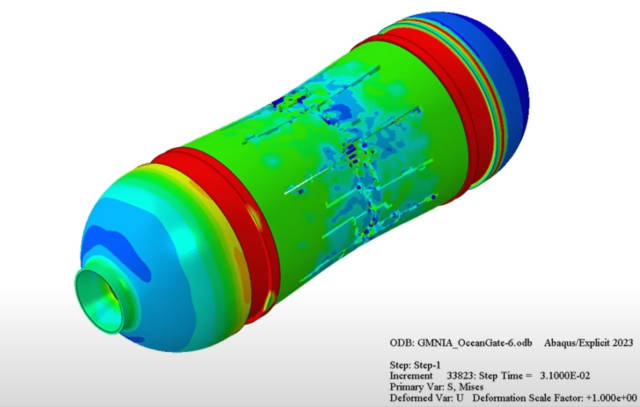
At 31 milliseconds, the carbon fiber hull is visibly deflecting. The hydrostatic pressure is acting to neck the cylinder around its middle as if tightening a deadly belt.
The Titan submersible launched on June 18, 2023 to take passengers to see the Titanic shipwreck. After an hour and 45 minutes, the vessel was not heard from again. Four days later, after an extensive search of the ocean surface along with the hope that the Titan would bob to the surface and its occupants would be freed before their oxygen ran out, the U.S. Coast Guard announced that the submersible had indeed imploded the day of its launch.
“This was a catastrophic implosion of the vessel,” said Rear Adm. John Mauger of the First Coast Guard District.
It may be of little consolation to the families of the victims of the Titan submersible that the implosion of the vessel took milliseconds. In that short amount of time, the brain cannot process pain. This is according to Dr. Chris Raynor, an orthopedic surgeon and YouTube star. In his viral video, now watched 2.8 million times, Raynor offers a sequence of events that results in pain sensation.
“There is a general process involved with feeling pain: first nerve endings called nociceptors detect pain usually within 0.1 to 1 millisecond; signals then travel to the spinal cord through nerve fibers, taking approximately 5 to 50 milliseconds; initial neural processing occurs in the spinal cord taking around 3 to 10 milliseconds; and finally the brain processes the signals and pain is perceived within tens to hundreds of milliseconds.”

Would They Have Seen It Coming?
The consensus of experts online seems to be that an implosion at such depths (the Titan was supposedly most of the way to the ocean floor, say, about 3,000 meters) would result in an implosion that generated so much force in such little time that the victims would have perished without ever knowing what hit them. They offer calculations that support this: light takes around 1 to 10 milliseconds to reach the retina, it takes a few more milliseconds to convert the light into electrical signals, and it takes 1 to 10 milliseconds for the signals to arrive at the brain, which then takes hundreds of milliseconds to register the signal as vision.
It may be soothing to hear that the victims never saw the hull failing in front of their eyes when it was too late to do anything about it, that their lives were extinguished without even a jolt of panic (much less pain). This is supported by a detailed simulation that breaks the implosion down to millisecond intervals.
Ronald Wagner (PhD Engineering, Technical University Braunschweig), an expert in the buckling of thin-walled shell structures, took it upon himself to perform A Nonlinear Structural Analysis of the Titan Submersible Shows Implosion and Fracturing, with linear and nonlinear simulations of the Titan submersible, scraping up as much geometry of the vessel as anyone has done, applying loads appropriate to the depth that the vessel traveled and with best guesses as to materials used. He analyzed three modes of failure—the viewport, the adhesive seal between the titanium endcaps and the collapse of the cylindrical hull. Of the three, the analysis of the latter is the most illuminating in the darkness of the tragedy. Using Abaqus, which is well suited to nonlinear finite element analysis (FEA), Wagner is able to show not only how the implosion occurred, as would high-speed photography played back frame by frame, but also explain as no one has been able to do until now, the manner in which the carbon fiber may have shattered.
Guesses about how the carbon fiber hull may or may not be found have ranged from microscopic fragmentation, essentially dust lost forever in the ocean floor, to a single hyperdense object made with jackhammer force from the high-pressure differential applied suddenly—making a fused little lump that has only slightly more likelihood of being found.
Visual indication of the hull collapse would have been preceded by loud creaks and pops. An acoustic analysis was not part of this simulation. The Titan had been equipped with a patented hull monitoring system and its sensors, most of which were located on the hull, would have been hooked up to alarms, so the alarms would have gone off. The protocol in such a situation is to drop ballast and ascend to a safer depth as fast as possible.
Was There Enough Time?
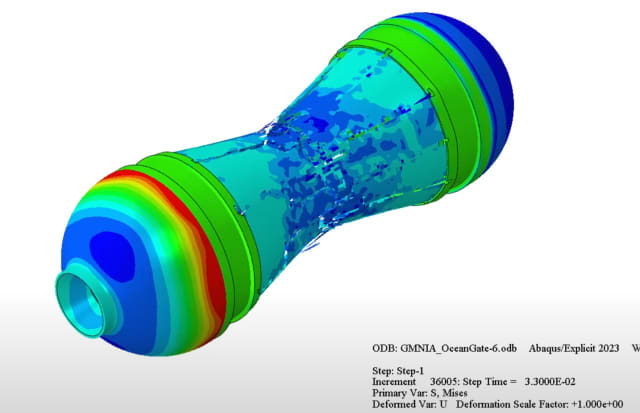
At 33 milliseconds, the middle of the cylinder has collapsed to about half its diameter. Still, the submersible appears to be intact.
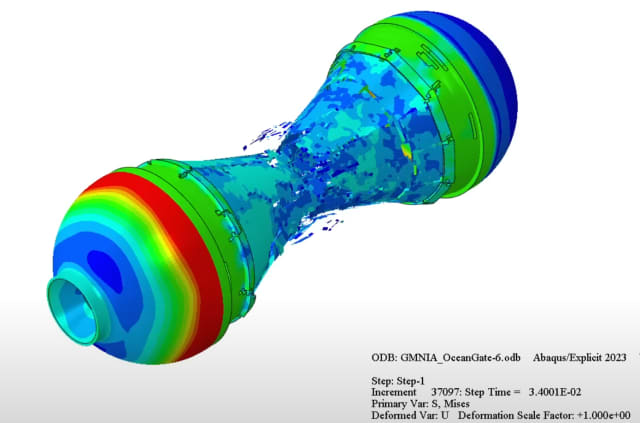
At 34 milliseconds, the cylinder is pinched small enough to have crushed anyone seated in the middle of the vessel, and worse—the hull seems to be breaking up. Fragments above the pinched middle would be from compression failure from the bending of the hull. Carbon fiber in composites fails in compression before it fails in tension. There are many reasons why, but design engineers have learned to expect only half of the tensile load when the material is in compression. The fibers on the inside of the vessel could be stretched, but the fibers on the outside have crumpled. With enough energy, the material would have broken off as shown.
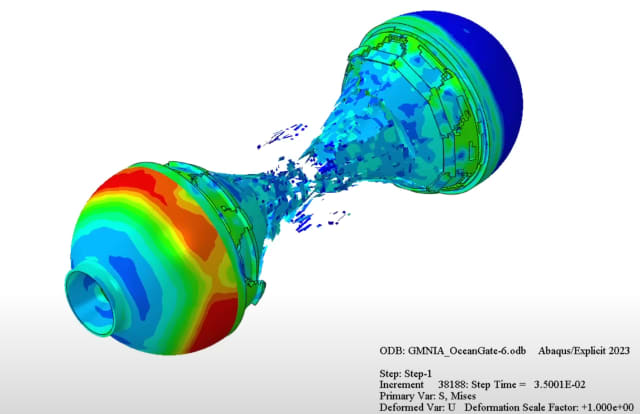
The middle of the Titan gives way at time = 35 milliseconds. This ultimate failure of the material happens before the diameter goes to zero, disproving the theory that the massive external pressure would have fused the hull into one piece. Note the titanium domes are still intact, but the titanium ring between the carbon fiber hull and the hemispherical titanium caps has cracked and is collapsing inward, following the carbon fiber hull. Separation of the hull and the rush of water combined with fragments of composite material would have a horrible pulverizing effect on any animal tissue, even bone. Nobody could possibly be left intact.
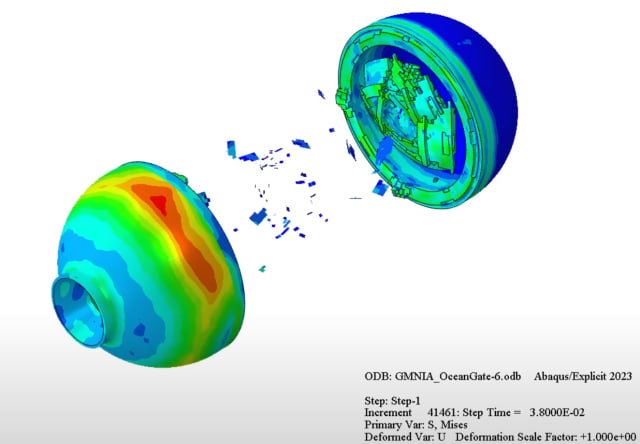
In 38 milliseconds, fragments of the titanium ring and hull have been thrust into the endcaps. If there was any hope of finding human remains preserved by the integrity of the endcaps, this simulation proves otherwise.
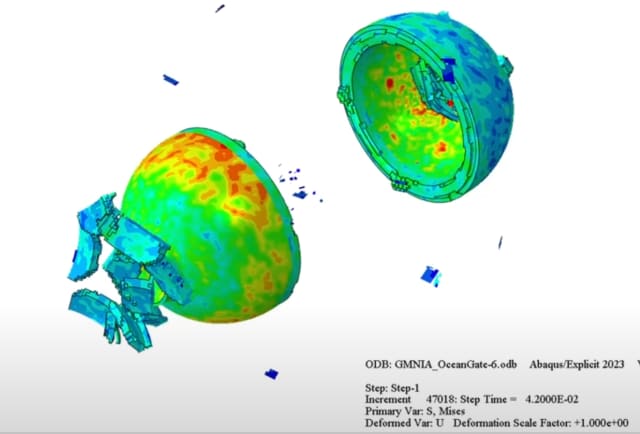
At 42 milliseconds, debris appears to have been propelled into the volume around what was once the submersible. The hemispherical shells are still intact but are now closer together. This may be due to pressure still applied to the endcaps creating a net force on the axis of what was once a cylinder. Note the difference between the fragments of the titanium rings (large pieces in light blue) and smaller pieces of the hull.
The analysis tends to confirm that the carbon fiber hull would have broken into small pieces and also helps to explain why, although larger pieces of debris have all been recovered (like the endcap, fairing, power and propulsion system and legs), no part of the carbon fiber hull has been found.
In Wagner’s estimation, it takes 13 milliseconds for the brain to process information from the eye, a hundred milliseconds to feel pain. But 13 milliseconds into the implosion, there is nothing left intact of the cylindrical section of the Titan.
“They would have been dead ten milliseconds ago,” says Wagner. “They wouldn’t really feel anything or see anything coming. They would just be instantly dead.”
Corrections made on July 19, 2023: Added quote from Ronald Wagner, analyst performing the simulation. Time sequence changed to step time in milliseconds instead of increment. Depth at implosion changed to 3,000 meters.
BY: Roopinder Tara, Engineering.com








